In a new study led by the University at Buffalo entitled “PrinTracker: Fingerprinting 3D Printers Using Commodity Scanners,” researchers may have made a breakthrough in how to trace a 3D printed object to the printer on which it was made. It’s believed to be the first accurate method for doing so, and could be extremely valuable in identifying the origin of things like counterfeit products and 3D printed guns.
“3D printing has many wonderful uses, but it’s also a counterfeiter’s dream. Even more concerning, it has the potential to make firearms more readily available to people who are not allowed to possess them,” said the study’s lead author Wenyao Xu, PhD, Associate Professor of Computer Science and Engineering in UB’s School of Engineering and Applied Sciences.
The method centers on infill, the core of the 3D print that is rarely seen but that has a big impact on a part’s strength and weight. Many different patterns can be selected for infill, but those patterns are typically pretty uniform from printer to printer – right? Not so, in fact. Depending on the 3D printer, the dimensions of the infill can vary from 5 to 10 percent from the size chosen – and each printer is unique in the infill it generates. Therefore, every printer essentially has a unique fingerprint.
“3D printers are built to be the same,” said Xu. “But there are slight variations in their hardware created during the manufacturing process that lead to unique, inevitable and unchangeable patterns in every object they print.”
 To test their model, the researchers used 14 common 3D printers to print five door keys each. 10 of the printers were FDM, and four were SLA. With an inkjet scanner, they created digital models of each key. They then enhanced and filtered each image and identified elements of the infill pattern. An algorithm was developed to align and calculate the variations of each key to authenticate the fingerprint. This created a fingerprint database for each of the 14 3D printers.
To test their model, the researchers used 14 common 3D printers to print five door keys each. 10 of the printers were FDM, and four were SLA. With an inkjet scanner, they created digital models of each key. They then enhanced and filtered each image and identified elements of the infill pattern. An algorithm was developed to align and calculate the variations of each key to authenticate the fingerprint. This created a fingerprint database for each of the 14 3D printers.
The researchers were able to match the key to the 3D printer it came from, using its fingerprint, 99.8% of the time. 10 months later, they ran a new series of tests to see if additional use of the 3D printers would change the results. It did not – the results were the same. The researchers also ran tests on keys that had been damaged in some way to obscure their identity. In these cases, PrinTracker was accurate 92% of the time.
According to Xu, PrinTracker can be used to trace any 3D printed object back to its source. He compares the technology to that used by law enforcement agencies and 2D printer companies to identify the source of paper documents.
“We’ve demonstrated that PrinTracker is an effective, robust and reliable way that law enforcement agencies, as well as businesses concerned about intellectual property, can trace the origin of 3D-printed goods,” Xu said.
The study will be presented in Toronto at the Association for Computing Machinery’s Conference on Computer and Communications Security, which runs from October 15th to 19th.
Authors of the paper include Zhengxiong Li, Aditya Singh Rathore, Chen Song, Sheng Wei, Yanzhi Wang and Wenyao Xu.
Discuss this and other 3D printing topics at 3DPrintBoard.com or share your thoughts below.
[Source/Images: University at Buffalo]Subscribe to Our Email Newsletter
Stay up-to-date on all the latest news from the 3D printing industry and receive information and offers from third party vendors.
Print Services
Upload your 3D Models and get them printed quickly and efficiently.
You May Also Like
Heating Up: 3D Systems’ Scott Green Discusses 3D Printing’s Potential in the Data Center Industry
The relentless rise of NVIDIA, the steadily increasing pledges of major private and public investments in national infrastructure projects around the world, and the general cultural obsession with AI have...
AM Research Webinar Explores Continuum’s Sustainable Metal Additive Manufacturing Powders
Metal additive manufacturing (AM) powder supplier Continuum Powders is working to develop solutions that empower industries to reduce waste and optimize their resources. An independent life cycle assessment (LCA) of...
AM Research Report Predicts Dental 3D Printing Market to Reach $9.6B in Revenue by 2033
One of the most mainstream applications of additive manufacturing (AM) technology in the medical industry is dentistry, from implants and orthodontics to prosthodontics and more. At the end of 2024,...
AM Research Says 3D Printing Could Be Responsible for Half the Parts on Launched Satellites by 2033
The satellite industry has grown significantly in the last decade. In the “new space race” between the more industrialized nations of the world, stiff competition has resulted in new and...




































